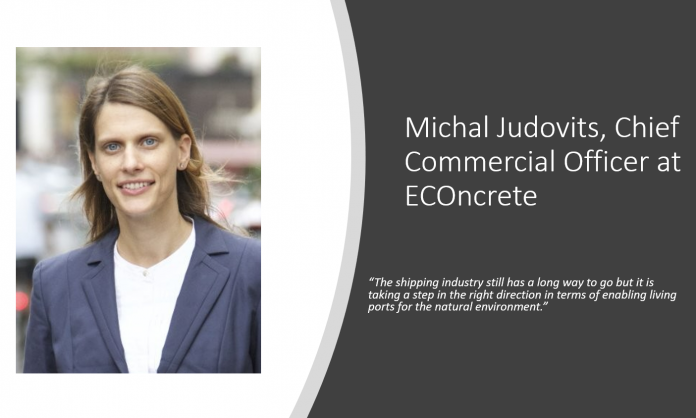Container News continues with a series of Q&A interviews with Michal Judovits, Chief Commercial Officer at ECOncrete, taking her position and sharing her views on the progress of the shipping industry’s decarbonisation process.
Michal Judovits and Container News managing editor Antonis Karamalegos discuss the shipping sector decarbonisation levels, expectations for the coming years and the actions needed for the next step towards a “green” shipping industry.
- After several announcements from shipping companies and organizations, which highlight the industry’s commitment to emissions reduction, what are your expectations for 2022?
It’s great to see the industry turn its attention towards emission reduction strategies!
At ECOncrete, we are expecting 2022 to be a big year. We will continue to build awareness in the ports, shoreline and offshore markets for the need to develop more sustainable infrastructure. ECOncrete’s technology reduces the carbon footprint by up to 70% compared to standard concrete.
And infrastructure built with ECOncrete technology actively stores CO2 for its lifetime, serving as an active carbon sink. For example, our proprietary technology promotes biocalcification and photosynthesis which can store 300 grams of CO2 per square metre per year for 1km of seawall – which is the equivalent of planting 100 adult trees every year.
- How do you see the shipping sector in the next ten years in terms of sustainability-transition?
The shipping sector has a huge responsibility to transition to more sustainable practices.
ECOncrete is ready to play a key part in the sustainability-transition of the shipping sector by building more sustainable, environmentally effective, and climate-adapted ports and waterways.
Port developers are increasingly starting to appreciate solutions with significant ecological benefits, which do not compromise on the structural performance.
In one of our projects, completed last year, the Port of San Diego required structural solutions to enable it to fulfil its responsibilities of helping to facilitate global trade. Our COSTALOCK solution provides carbon sequestration, a smaller ecological footprint overall, while providing resilience and protection of port assets.
- What actions should shipping stakeholders take to meet the global climate targets?
All shipping stakeholders need to work together, and on all levels, to meet the global climate targets. With our technology we are setting a new standard in responsible and sustainable marine infrastructure construction, already used in dozens of locations around the globe (from Rotterdam to Vigo and San Diego).
Infrastructure developed with ECOncrete technology will see a healthier marine ecosystem, and will contribute directly to the global climate targets, with an active carbon sink and cleaner water. We provide a unique solution to meet the needs of ports and marine construction.
Through our high-performance solutions, we are helping a range of shipping industry stakeholders to pursue global climate targets.
- Comparing with other sectors (automotive, aviation, etc.), do you believe that the shipping sector stands at a “satisfying” level regarding its eco-friendly tactics and measures?
We aren’t in a position to comment on the efforts of sectors other than those in which we operate.
The shipping industry still has a long way to go but it is taking a step in the right direction in terms of enabling living ports for the natural environment.
Some of our projects demonstrate this and we eagerly anticipate more opportunities to implement our technology in ports, waterways and offshore construction across the world!







